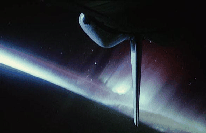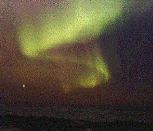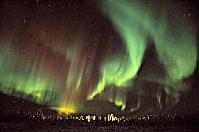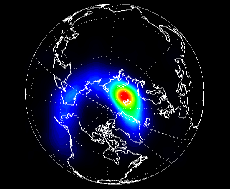 |  |
 |
| Southern aurora from the Space Shuttle Endeavor (Ref) | Northern aurora over Lake Superior (Ref) | Northern aurora over Circle, Alaska (Ref) |
The
aurora, or
northern and southern lights,
are often visible from the surface of the
Earth at high northern or southern latitudes.
Auroras typically
appear as luminous bands or
streamers that can
extend to altitudes of 200 miles (well into the
ionosphere).
Northern and Southern Lights
The following figures show three examples of the often spectacular
visible light display
associated with auroras.
 |  |
 |
| Southern aurora from the Space Shuttle Endeavor (Ref) | Northern aurora over Lake Superior (Ref) | Northern aurora over Circle, Alaska (Ref) |
Here is another image of the southern aurora taken from the Space Shuttle. The aurora changes with time, often looking like moving curtains of light. Here are some MPEG and QuickTime film clips that illustrate the time dependence of the auroral display.
The delicate colors are caused by energetic electrons colliding with oxygen and nitrogen molecules in the atmosphere. This excites the molecules, and when they decay from the excited states they emit the light that we see in the aurora.
Auroras at Non-Visible Wavelengths
The collisions of trapped charged particles with atmospheric molecules causes
spectacular effects in the visible spectrum, but these excited molecules can
also
emit radiation in other wavelength bands. The following figures show aurora
imaged in the ultraviolet (UV) and X-ray regions of the spectrum.
 |
 |
| UV emission from northern aurora observed by the Polar satellite (Ref) | X-ray emission from northern aurora observed by the Polar Satellite (Ref) |
These images were obtained by the NASA Polar Satellite. The X-ray image represents the first global photograph of an aurora in the X-ray spectrum.